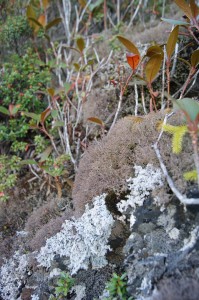Getting Lichens on the List—The IUCN Red List, That Is
Posted in Environment on February 19, 2016 by James Lendemer
James C. Lendemer, Ph.D., is an Assistant Curator in the Institute of Systematic Botany at The New York Botanical Garden. Lichens, which include a fungal component, are his primary research interest.

Lichens, like other fungi, are poorly represented in conservation efforts in the United States and Canada as well as most other countries outside of Europe. At the beginning of 2015, only two lichens were protected under the US Endangered Species Act, 16 were protected under similar legislation in Canada, and two were listed internationally on the Red List of threatened species, which is maintained by the International Union for the Conservation of Nature (IUCN). At the state level, slightly higher numbers of lichens and other fungi are protected, although coverage is highly variable and no state has a comprehensive assessment of all the lichens within its borders.
The lack of protections for lichens is not, however, due to a lack of knowledge about the threats species face and the declines they have already suffered. Instead, there is a tremendous wealth of information stored in museums and in decades of firsthand knowledge held in the minds of American and Canadian lichenologists.
Recognizing that lichens were neither unknown nor unknowable, we organized a meeting at The New York Botanical Garden to advance the cause of lichen conservation internationally. For three days last year, we met with Troy McMullin, Ph.D., from the Canadian Museum of Nature and Christoph Scheidegger, Ph.D., from the Swiss Federal Institute for Forest, Snow, and Landscape Research. Our goal was to produce the first complete IUCN assessments for a selection of lichens from North America that we knew to be threatened or endangered.
We spent hours in long discussions, examined herbarium specimens from the Botanical Garden’s William and Lynda Steere Herbarium as well as other institutions, vetted online records from natural history collections digitized by Herbarium employees, studied land use maps and DNA sequences, mapped populations and modeled species distributions.
The results were assessments for more than 30 species that we determined could be ranked as vulnerable, endangered or critically endangered. These lichens range from tiny crusts that live in old-growth forests that remain on the highest peaks of the mountains in southeastern North America to large rope-like species found along the Pacific Coast of California, and even a reindeer lichen found in the New York City metropolitan area. Now our assessments must undergo a formal review process. Stay tuned as we follow the path our species take on their way to the Red List.
The NYBG meeting was supported by the Mohamed bin Zayed Species Conservation Fund.
Digitization of lichen specimens is supported by the National Science Foundation’s TCN Lichen and Bryophytes project.

